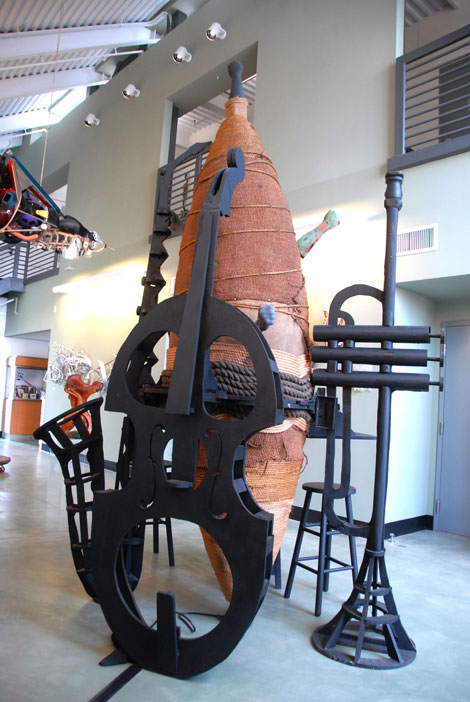The sprawling Charles Dickson retrospective, dispersed throughout the Purifoy Gallery at the Watts Towers Arts Center and the Mingus Gallery in the Charles Mingus Youth Arts Center, exhibits an artist who knew he was born with a gift and that his life’s work was to be an artist or “creative agent.” Over 70 pieces showcase the artist’s vast range, while exploring his extensive skill set.
A wall relief entitled Inside Out (2008) features an inverted Lexus hood whose underside reveals what was once concealed and is now exposed; this piece is embellished with arranged objects that are specific to the artist’s person, i.e., eye mask, inhalers, small sculptures, wood chisels and mallets, which combine to form a “material self-portrait.”
With Steppin’ In, Steppin’Off, Steppin’ On (1989) we find a visual compliment to Inside Out, concerning itself with metamorphosis, transformation and time. The viewer encounters a life-size African-American female figure stepping into the gallery’s space, emerging from a wall/womb, shedding a Plexiglas chrysalis while pushing through to actual space, duplicating the motion of time-lapse photography and traveling through multiple dimensions. Dickson’s devotion to detail rivals artists Bob Graham, Tina Allen and Frank Cummings. The figure performs an impossible balancing act, extending off the gallery’s wall a considerable distance into the gallery. The sculpture’s volume and mass contradicts our sense of weight. Dickson visually floats the piece in its own holographic space. Sistah’s Body Spirits (1978) is part of his running homage to African-American women. The body cast of four life-size women surrounding a young girl’s body cast offers a visual reminder of the African proverb, “It takes a whole village to raise a child.”
The Mingus Gallery was the site of several significant works that included a drawing table (2005) belonging to master watercolorist Bill Pajaud. The table skillfully blurred lines between high-end sculpture and customized furniture. It offered a unique collaboration point between Dickson and Pajaud. Dickson would “tag” Pajaud’s table structure with carved images reproduced from Pajaud’s sketchbook to create a 3D tagging and branding system.
Serve It Up (2010), also in the Mingus Gallery, is an imposing piece by virtue of its physical scale (nearly two stories high) and code switching. The mixed media sculpture moves beyond being a mere tableau and becomes a ritual site where a circular counter stocked with an ample supply of liquid libation is served up to the spirits. It also holds the energy of “walking the bar,” that convoluted humiliating behavior that involved black jazz musicians, particularly horn players during the ’40s and ’50s, walking across a bar counter while playing. Dickson fabricated an oversized wooden sax, trumpet and bass, leaning against the edge of the bar, on the verge of “serving up” an ascending cloud of notes, designed to invoke and stir up the Spirits. In doing so, a tilted vortex of polyrhythmic energy coalesces like John Coltrane and Elvin Jones, themselves sending up sacred offerings.


